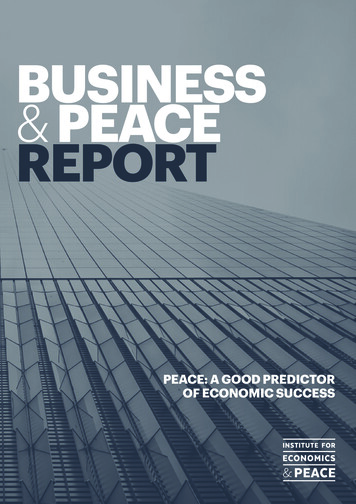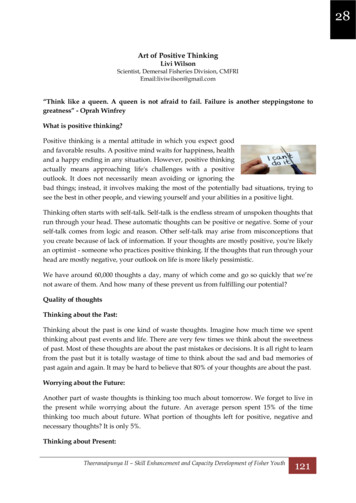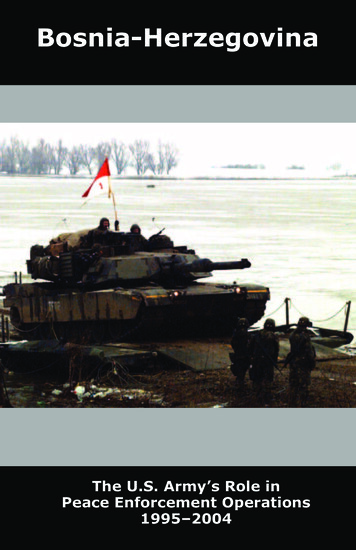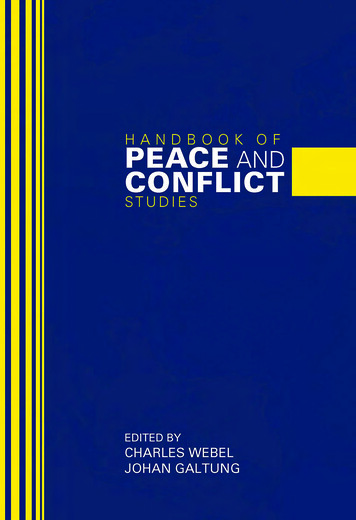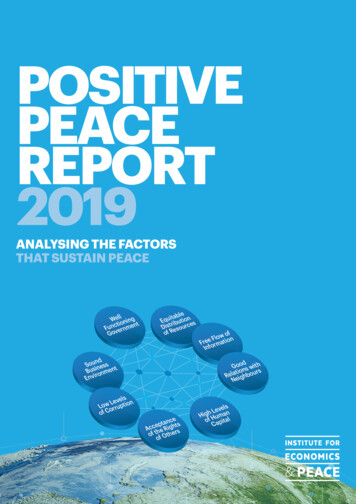
Transcription
POSITIVEPEACEREPORT2019ANALYSING THE FACTORSTHAT SUSTAIN PEACEWell ningtiontFuncvernmeoGetablEquiribution sDist esourceof RndSou iness tBus onmenrEnvilsLeve nLow orruptioof Coflow ionFeFre ormatInfdGoons withoirstRelaeighbouNetanchtspecAc he Rig rsof t f OtheolsLeveanhgiH Hum lof apitaC
Quantifying Peace and its BenefitsThe Institute for Economics & Peace (IEP) is an independent, non-partisan, non-profit think tank dedicated toshifting the world’s focus to peace as a positive, achievable, and tangible measure of human wellbeing andprogress.IEP achieves its goals by developing new conceptual frameworks to define peacefulness, providing metricsfor measuring peace and uncovering the relationships between business, peace and prosperity, as well aspromoting a better understanding of the cultural, economic and political factors that create peace.IEP is headquartered in Sydney, with offices in New York, The Hague, Mexico City, Brussels and Harare. Itworks with a wide range of partners internationally and collaborates with intergovernmental organisationson measuring and communicating the economic value of peace.For more information visit www.economicsandpeace.orgPlease cite this report as:Institute for Economics & Peace. Positive Peace Report 2019: Analysing the Factors that Sustain Peace,Sydney, October 2019. Available from: http://visionofhumanity.org/reports (accessed Date Month Year).
ContentsWhy Positive Peace is TransformationalExecutive SummaryKey FindingsWhat is Positive Peace?10121415Section 1: Positive Peace Index, Results & Trends2018 Positive Peace Index RankingsGlobal Trends in Positive PeaceRisers and Fallers in Positive PeaceUS, China, EU and UK2326283344Section 2: Positive Peace, Ethical Investment and ResiliencePositive Peace & Ethical InvestmentPositive Peace & Economic ResiliencePositive Peace & Social Resilience49515460Section 3: Positive Peace & changes in GPI ScoresHistorical Changes in PeaceUneven Progress in Positive Peace646574Section 4: Implementing Positive PeaceCountry Case StudiesIEP’s Positive Peace Programs767678Appendix A: Positive Peace Index MethodologyAppendix B: Positive Peace Index resultsEndnotes848791POSITIVE PEACE REPORT 2019 1
Positive PeacePositive Peace creates the optimal environmentfor human potential to flourishWell ningtiontFuncvernmeGoetablEquiribution sDist esourceof RndSou iness tBus onmenrEnvilsLeve tionwopL orruof Coflow ionFeetFr ormaInfdGoons withoirstRelaeighbouNnceepta ightsccA he R rsof t f OtheoPOSITIVE PEACE REPORT 2019 2lsLeveanhgiH Hum lof apitaC
High levels of Positive Peace lead s45Better performanceon developmentgoalsHigher percapita incomeHigher measuresof wellbeingPositive Peace & Financial Metrics Every one index point of improvement in the Positive Peace Index is associated with atwo percentage point rise in GDP per capita. Household consumption in countries improving in Positive Peace grows at twice therate relative to countries where Positive Peace deteriorates. Growth in business activity in countries where Positive Peace improved was six timeshigher than in countries where the PPI deteriorated in the past decade. Domestic currency in countries where Positive Peace improved appreciated by 1.3percentage points per year more than countries where it deteriorated. Inflation rates in countries where Positive Peace deteriorated were four times morevolatile when compared to countries where Positive Peace improved. Among PPI improvers, foreign direct investment grew by seven per cent per year inthe past decade. This compares with a decline in investment where Positive Peacedeteriorated.POSITIVE PEACE REPORT 2019 3
1.jjjjStrongerresilienceCountries in which the PPI improves are lessprone to political shocks and social tensions,an obvious benefit for investors seeking toprotect their capital from non-economicdisruptions.Nations with high levels of Positive Peacerecord far less fatalities per natural disasterthan nations with low levels of PositivePeace.FIGURE 2.18Distribution of Endogenous Shocks,2009–2018Lower Positive Peace countries experience more shocks.Total incidents (%)GenocideOnset(2005 2014)0204060001202642183870Very HighHighMediumLowViolentConflict Onset(2005 2014)PoliticalShock Onset(2005 2014)POSITIVE PEACESource: INSCR, UCDP, IEPFIGURE 2.19Total number of deaths from natural disasters,2009–2018Natural disasters are only slightly more frequent in lowPositive Peace countries, yet they have 13 times more fatalitieswhen compared to high Positive Peace environments.FIGURE 2.20Frequency of natural disasters, 2009–2018Natural disasters occur almost as often in low Positive Peacecountries as in high Positive Peace ones.800600,000NUMBER OF NATURAL DISASTERSNUMBER OF FATALITIES FROMNATURAL 00000Very HighHighMediumLowVery HighMediumPOSITIVE PEACE LEVELSPOSITIVE PEACE LEVELSSource: EMDAT, IEPHighSource: EMDAT, IEPPOSITIVE PEACE REPORT 2019 4Low
2.Better environmentaloutcomesFIGURE 2.3jjPositive Peace has a high correlation withindicators of environmental, social andgovernance (ESG) investment. Designersof financial products and benchmarks canuse this comparison when catering for thegrowing demand for ethical investment.High Positive Peace nations record betteroutcomes in measures of environmentalhealth.ESG scores and Positive Peace, 2017Countries that score well in ESG criteria tend to record strongerPositive Peace outcomes.100Less developedMore developedABERDEEN: ESGP EM SOVEREIGN SCOREjjr -0.9475502502.02.5More peaceful3.03.54.0Less peacefulPPI OVERALL SCORESource: Aberdeen Standard, IEPFIGURE 2.4Environmental performance scores and Positive Peace, 2018Countries with high Positive Peace—whose PPI is above the median for 2018—record stronger environmental performance.WorseBetterYALE ENVIRONMENTAL PERFORMANCE INDEX:ENVIRONMENTAL HEALTH80706050403020100Low Positive PeaceHigh Positive PeacePPI OVERALL SCORESource: Yale Environmental Performance Index, IEPPOSITIVE PEACE REPORT 2019 5
3.Higher measuresof wellbeingjjIn addition to economic prosperity, Positive Peace is alsoassociated with greater social wellbeing, as evidenced by theclose relationship between the PPI and the Social ProgressImperative’s Foundations of Wellbeing scores.FIGURE 2.2Social wellbeing and Positive Peace, 2018There is a close correlation between the SPI Foundations of Wellbeing scores and PPI scores.Lesser wellbeingGreater wellbeingFOUNDATIONS OF WELLBEING100r -0.938060402012More peaceful3PPI OVERALL SCORESource: Social Progress Imperative, IEPPOSITIVE PEACE REPORT 2019 64Less peaceful
4.Better performanceon development goalsjjBetween 2000 to 2015, countries with high Positive Peace performancetended to be more advanced in the United Nations MillenniumDevelopment Goals.FIGURE 2.5Millennium development goals and Positive PeaceCountries with high Positive Peace performance—PPI score above median—tend to be more advanced in the UN MillenniumDevelopment Goals.WorseBetterMDG PROGRESS SCORE, 20113.83.63.43.23.0Low Positive PeaceHigh Positive PeacePPI SCORE, 2011Source: United Nations, IEPNote: The MDGs are used as SDG16 data compilation is ongoing.POSITIVE PEACE REPORT 2019 7
5.Higher percapita incomejjPositive Peace is a reliable gauge of economic resilience and can be used toselect portfolios of countries that consistently outperform global GDP growth.jjThis outperformance is also verified for other indicators of macroeconomicactivity and national governance.jjEvery one index point of improvement in the PPI is associated with a twopercentage point rise in GDP per capita.jjCountries that improved in Positive Peace from 2009 to 2018 experiencedsubstantially lower volatility of inflation over this time.FIGURE 2.1Countries that improve in Positive Peace outperform the global averageGrowth in real GDP of a portfolio of countries that improve in Positive Peace exceeds an equally weighted global average by onepercentage point per year.141REAL GDP, INDEX (2010 100)140Positive Peace Improvers132130120All countries1101002010Source: World Bank, IEP20122014YEARPOSITIVE PEACE REPORT 2019 820162018
FIGURE 2.6Positive Peace and GDP per capita, 2018On average, across all levels of country income, every one index point improvement in the Positive Peace Index is associated witha two percentage point rise in GDP per capita.r -0.90LOG GDP PER CAPITA1086123POSITIVE PEACE INDEXMore peacefulSource: World Bank, IEPFIGURE 2.9Volatility of inflation rates by Positive Peaceoutcome, 2009–2018STANDARD DEVIATION OF INFLATIONRATES (PERCENTAGE POINTS PER YEAR)Countries in which Positive Peace deteriorated recorded astandard deviation of inflation rates much greater than thosecountries where the PPI improved.12840Positive PeaceImproversPositive PeaceDeterioratorsSource: World Bank, IEPPOSITIVE PEACE REPORT 2019 94Less peaceful
WHY POSITIVE PEACE ISTRANSFORMATIONALPositive Peace is a transformational concept. Empirically based, it shifts the focus away from the negative to the positiveaspects that create the conditions for a society to flourish. Due to its systemic nature, improvements in Positive Peace areassociated with many desirable outcomes for society, such as higher GDP growth, better measures of wellbeing, higherlevels of resilience and more peaceful societies. More importantly, it provides a theory of social change, and explains howsocieties change and evolve.Humanity is nearing a tipping point and facing challenges unparalleled in its short history. Many of these problems areglobal in nature, such as climate change, ever-decreasing biodiversity, depletion of the earth’s freshwater, andoverpopulation. Such global challenges call for global solutions and require cooperation on a scale unprecedented inhuman history. In a hyper-connected world, the sources of many of these challenges are multidimensional, increasinglycomplex and span national borders. For this reason, finding solutions requires fundamentally new ways of thinking.Peace is the prerequisite for the survival of humanity in the 21stcentury. Without peace, it will not be possible to achieve thelevels of trust, cooperation and inclusiveness necessary to solvethese challenges, let alone empower the international institutionsand organisations necessary to address them. In the past, peacemay have been the domain of the altruistic, but in the currentcentury it is everyone’s self-interest.Without an understanding of the factors that create and sustainpeaceful societies, it will not be possible to develop theprogrammes, create the policies or understand the resourcesrequired to build peaceful and resilient societies.Positive Peace provides a framework to understand and toaddress the many complex challenges the world faces. PositivePeace is transformational in that it is a cross-cutting facilitator ofprogress, making it easier for businesses to sell, entrepreneursand scientists to innovate, individuals to produce andgovernments to effectively regulate.In addition to the absence of violence, Positive Peace is alsoassociated with many other social characteristics that areconsidered desirable, including stronger economic outcomes,higher resilience, better measures of wellbeing, higher levels ofinclusiveness and more sustainable environmental performance.Therefore, strong Positive Peace can be seen as creating anoptimal environment in which human potential can flourish.Understanding what creates sustainable peace cannot be foundin the study of violence alone.A parallel can be drawn with medical science. The study ofpathology has led to numerous breakthroughs in ourunderstanding of how to treat and cure disease. However, it wasonly when medical science turned its focus to the study ofhealthy human beings that we understood what we needed to doto stay healthy: physical exercise, a good mental disposition, anda balanced diet are some examples. This could only be learnedby studying what was working. In the same way, the study ofconflict is different from the study of peace, and produces verydifferent outcomes.Positive Peace is systemic and requires new thinking. Systemsthinking originated in the study of organisms, and is now used bysociologists. It can also assist in understanding the way countriesand nations function and evolve. When combined with PositivePeace, systems thinking provides new ways of conceptualisingand explaining societal change. As one example – a system ismore than the sum of its parts, and cannot be understood merelyby breaking it down and analysing its constituent parts. PositivePeace consists of eight Pillars, but each of these Pillars does notcorrelate with peace as strongly as the sum of all components,highlighting that the whole is more than its parts.This distinctly contrasts the notion of linear causality, whichdominates decision making today and involves identifying aproblem, detecting its cause, and tackling the root. Without afuller understanding of underlying system dynamics, the linearapproach creates unintended consequences. The failure to solvesome of society’s fundamental challenges is a testimony to this.Systems thinking opens new ways of understanding nations andhow they evolve. In systems, relationships and flows are moreimportant than events. Events or problems represent theoutcomes of the relationships and flows. This is why it isimportant to look at the multidimensional concept of PositivePeace as a holistic, systemic framework.Positive Peace defines the goals towards which a system needsto evolve. Interventions should nudge the system towards higherlevels of Positive Peace, rather than creating radical change,which runs the risk of ripping the fabric of society.Importantly, viewing nations as systems provides a framework forunderstanding the relationships between humanity and thebroader systems, such as the atmosphere and biosphere, whichwe intersect and depend upon. Systems are self-regulating andself-modifying and operate on two levels: first, as a collection ofinterconnected subsystems; and second, as part of the largersystems surrounding it. Understanding these interdependenciesis essential to meeting the global challenges of our age.Different countries have different aims, or intent. Societies alsohave both formal and informal rules, referred to as encodednorms, which govern societies, and aim to maintain the systemin a stable state. They regulate inputs, creating what is known asmutual feedback loops. This can be observed in many societalprocesses, such as when a government stimulates the economyin response to a drop in GDP or deploys more policing resourceswhen there is a rise in crime. Each country’s system will bePOSITIVE PEACE REPORT 2019 10
unique with different social norms and governance, althoughfollowing the same general principles.With differences in intent and encoded norms, any two nationsmay react differently to the same stimulus. Tipping points alsooccur within systems due to lagged and non-linear relationships.IEP’s research shows evidence of tipping points in relation topeace and corruption, and peace and per capita income, toname some examples. In the past, societies have beenunderstood through the lens of causality. In the future,embracing these holistic, systemic approaches will forge ourability to manage an age of unprecedented challenges.Seen in this light, Positive Peace and systems thinking comprisean overarching framework for understanding and achievingprogress not only in the level of global peacefulness, but in manyother interrelated areas, including better economic progress andsocial advancement.Positive Peace provides the optimal environment for humanpotential to flourish.Well ningtiontFuncvernmeGoetablEquiribution sDist esourceof Roflow ionFeFre ormatInfndSou iness tBus onmenrEnvilsLeve tionwoL orrupof CdGoons withorstiRelaeighbouNetanchtspecAc he Rig rsof t f Otheosevel nLhgaHi Hum lof apitaCPOSITIVE PEACE REPORT 2019 11
Executive SummaryThis report is a continuation of the prior work from the Institute for Economics and Peace (IEP), and includes updatedresults for the annual Positive Peace Index (PPI). It also provides analysis of countries that are improving or deteriorating inPositive Peace, as well as the developmental factors that improve or deteriorate with changes in Positive Peace. Theresearch incorporates systems thinking to understand how nations operate and societies develop over time. Theintroductory section of the report describes the fundamental concepts associated with systems thinking. In doing so, IEPprovides a new interdependent framework and holistic approach to understanding peace and development.The 2019 Positive Peace report outlines a new approach tosocietal development through the application of Positive Peaceand systems thinking. Positive Peace is defined as the attitudes,institutions and structures that create and sustain peacefulsocieties. The same factors that create peace also lead to manyother positive outcomes that societies aspire to, such asthriving economies, better inclusion, high levels of resilienceand societies that are more capable of adapting to change.Other factors positively associated with Positive Peace arebetter performance on handling ecological challenges,wellbeing and happiness. Therefore, Positive Peace creates theoptimal environment in which human potential can flourish.When combined with systems thinking, analysis of PositivePeace also yields a theory of social change. Developments inPositive Peace precede societal changes in peacefulness, forbetter or worse. Through building Positive Peace, a nation canimprove its overall trajectory in social development andpeacefulness. Stimuli and shocks have cascading effects, dueto the feedback loops contained within national systemspushing societies into virtuous or vicious cycles. However,these cycles can be understood, planned and moulded toproduce the best social outcomes. Positive Peace provides aroadmap of the things societies need to change, to eitherconsolidate virtuous cycles or break vicious ones.Positive Peace is also strongly linked to social resilience.Countries with high Positive Peace are more likely to maintainstability, adapt and recover from both internal and externalshocks. Eighty-four per cent of major political shocks occurredin countries with low Positive Peace. Similarly, there are 13times more lives lost from natural disasters in nations with lowPositive Peace, as opposed to those with high Positive Peace.Countries with stronger Positive Peace have restorativecapacities and as such are more resilient in times of civil unrest.Civil resistance movements tend to be smaller, linger forshorter periods, have moderate aims, are more likely to achievetheir goals, and be far less violent. The differences betweencountries can be striking: 91 per cent of all violent civilresistance campaigns have been waged in countries withweaker Positive Peace.In 2018, the economic impact of containing or dealing with theconsequences of violence was 11.2 per cent of the world grossdomestic product (GDP) or approximately 14 trillion,highlighting that improvements in resilience and peace havesubstantial economic advantages to the global economy.1Analysis finds that Positive Peace is strongly correlated topositive economic outcomes. Countries that develop high levelsof Positive Peace display greater degrees of economic strengthand resilience. As such, Positive Peace can be used in financialmarkets helping investors identify reliable and sustainablegrowth opportunities. Improvements in Positive Peace arestatistically associated with better performance in a range ofmacro-economic indicators, including stronger GDP growth,stronger flows of foreign direct investment, appreciatingcurrencies and lower and more stable interest and inflationrates.The concept is also closely linked empirically to the notion ofethical investing (ESG). Positive Peace is statistically linked toimprovements in ESG measures and as such can be seen ascreating the background environments where countries willperform well in ESG measures. Positive Peace can be used as apredictor of superior ESG performance and can be applied inthe design of impact-type investment strategies or as a riskassessment and management tool.Positive Peace has been improving since at least 2009, with 128of the 163 countries improving on the PPI, or 79 per cent, overthis period. However, much of this improvement has been dueto improvements within the Structures domain of Positive Peaceand includes measures related to factors, such as poverty andhealth, or those that are the result of aggregate activity, such asGDP. They tend to grow almost without interruptions, reflectingthe continuous increase in national incomes, the constantdevelopment of new technologies and the permanent stream ofnew discoveries in science and health.In contrast, factors relating to social attitudes, as measured bythe Attitudes domain, have recorded considerable deteriorationover the past decade. These factors measure social views,tensions and perceptions and have been negatively affected bythe increasing dissemination of false information, a rise incorruption, the greater polarisation of political views and theintensification of tensions between different social groups.Some countries have experienced steep declines in this domain,including well-developed countries, such as Denmark, Sweden,Austria and the UK.POSITIVE PEACE REPORT 2019 12
Seven of the eight Pillars of Positive Peace have improved overthe last decade. The one Pillar that continues to record adeterioration is Low Levels of Corruption.The Pillars with the greatest improvements over the pastdecade have been Free Flow of Information and Sound BusinessEnvironment. These developments mostly reflect thedissemination of information technologies and the growth ingoods and services consumption.Without a better understanding of how societies operate, it willnot be possible to solve humanity’s major global challenges.Positive Peace provides a unique framework to better managehuman affairs and relate to the broader ecosystems upon whichwe depend. Positive Peace in many ways is a facilitator, makingit easier for workers to produce, businesses to sell,entrepreneurs and scientists to innovate, and governments toserve the interests of their people.Each Pillar of Positive Peace represents a complex set of socialdynamics. IEP research finds that different Pillars become moreimportant at different stages of development. As countriesprogress toward higher levels of peacefulness, the eight Pillarsbuild on one another to consolidate mutually reinforcingsuccesses. Breakdowns in peace are preceded bydeteriorations in fewer indicators than what is needed toimprove peace, highlighting that to improve peace anddevelopment a broader set of initiatives are needed.Additionally, improvements in a single Pillar, withoutimprovements in other Pillars can lead to a higher likelihood ofdeteriorations in peace. Focusing exclusively on buildingstronger business environments or higher levels of education,for example, may prove to be problematic. Countries evolve likesystems. For interventions to be successful, the unique factorsthat constitute the make-up of a country need to beunderstood. Radical change also creates risk. The bestapproach is many small nudges to improve Positive Peace.Taken together, the findings in this report have importantimplications for building and sustaining peace: There is no silver bullet. Building and sustaining peacerequires a large number of society-wide improvementsprogressing in concert with one another over a long periodof time. Simply addressing the factors that led to violence in thepast will not be enough to sustain peace. Different aspectsof the social system push societies toward or away frompeace, which means that improvements in peace requirebroader, systemic strategies than once thought. Prevention should be the priority. Recovery after violencehas already occurred is difficult, expensive, and requireswidespread effort to rebuild Positive Peace. Throughfocusing on the factors that are most vulnerable, it ispossible to build resilience in the most cost-effective way. Stopping or preventing conflict is not an end in itself. AsPositive Peace progresses, it enables an environment wherehuman potential has more avenues to flourish.“Simply addressing the factorsthat led to violence in the pastwill not be enough to sustainpeace. Improvements in peacerequire broader and moresystemic strategies than oncethought.”Positive Peace can also be applied practically throughworkshops and development projects, which have beenimplemented in all major regions of the world, through IEP’sextensive partnership network. The workshops are effective atthe national, state or community level. This report includesexamples of a series of workshops that IEP has conducted forLibya, Zimbabwe, Uganda and Mexico aimed at buildingPositive Peace in these countries and communities.POSITIVE PEACE REPORT 2019 13
Key FindingsPositive Peace fundamentalscountries that consistently outperform global GDPgrowth.jjPositive Peace is defined as the attitudes, institutionsand structures that create and sustain peacefulsocieties.jj This outperformance is also verified for other indicatorsof macroeconomic activity and national governance.jjThese same factors also lead to many other positiveoutcomes that society feels are important, such aseconomic strength, resilience and wellbeing.jj Every one index point of improvement in the PPI isassociated with a two percentage point rise in GDP percapita.jjTherefore, Positive Peace creates the optimalenvironment for human potential to flourish.jjThe most peaceful countries in the world performstrongly on all eight Pillars of Positive Peace.jj Inflation rates in countries where Positive Peacedeteriorated were four times more volatile whencompared to countries where Positive Peace improved.jjHigh Positive Peace countries are more likely tomaintain stability, adapt, and recover from shocks asthey overcome their challenges.jjCountries that progress in Positive Peace are morelikely to maintain high levels of peace.jjThe level of Positive Peace is a country’s best longterm indicator of how peaceful a country is likely to be.Global and regional trendsjj Many more countries improved in Positive Peace thandeteriorated, with 128 countries showing improvementand 35 countries showing deteriorations, since 2009.jj Positive Peace improved 2.6 per cent globally in thepast decade, driven by improvements in seven of theeight Pillars of Positive Peace since 2009.jj These improvements were mainly driven by Free-Flowof Information, Sound Business Environment and HighLevels of Human Capital.jj Improvements in the PPI are mainly due toimprovements in the Structures domain of PositivePeace, while the Institutions domain was steady andthe Attitudes domain deteriorated.jj The Attitudes domain deteriorated by four per centreflecting deteriorations in the quality of information,factionalised elites and hostility to foreigners/privateproperty.jj Eight out of the nine world regions improved in PositivePeace from 2009 to 2018, with North America beingthe only exception.jj Russia and Eurasia, Asia-Pacific, and South Asia hadthe largest regional improvements, with all countriesimproving in Russia and Eurasia and South Asia.jj The largest improvements in Positive Peace occurredin Georgia, Belarus, Côte d'Ivoire, Armenia and SaudiArabia and Belarus. However, these countries beganfrom low levels of Positive Peace in 2009.jj The largest deteriorations in Positive Peace occurred inSyria, Libya, Yemen, Venezuela and Brazil.Positive Peace, ethical investment and resiliencejj Positive Peace has a high correlation with indicatorsof environmental, social and governance (ESG)investment. Designers of financial products andbenchmarks can use this comparison when cateringfor the growing demand for ethical investment.jj Positive Peace is a reliable gauge of economicresilience and can be used to select portfolios ofjj Domestic currency in countries where Positive Peaceimproved appreciated by 1.3 percentage points perannum more than countries where it deteriorated.jj Countries that improved in Positive Peace also havea more positive credit rating outlook as assessed byStandard & Poor’s, Moody’s and Fitch.jj Among countries where Positive Peace improved,household consumption rose in the past decade ata rate twice as high as for countries where the PPIdeteriorated.jj Growth in business activity in countries where PositivePeace improved is six times higher than in countrieswhere the PPI deteriorated.jj Countries seeing Positive Peace improvements aremore attractive to foreign investors, with foreign directinvestment (FDI) and trade growing strongly overthe last decade. This contrasts with stagnant FDI incountries where Positive Peace deteriorates.Positive Peace and changes on the Global Peace Indexjj 75 per cent of countries identified as high risk inIEP’s Positive Peace Deficit model had significantdeteriorations in peace between 2009 and 2018. Onaverage, these countries had a deterioration in peaceof 11 per cent, as measured by the GPI.jj Countries IEP identified as having strengths in PositivePeace on average improved in the GPI by 2 per centover the past decade.jj Well-Functioning Government, Low Levels ofCorruption, Acceptance of the Rights of Others andGood Relations with Neighbours are the most importantPillars needing improvement in countries suffering fromhigh levels of violence.jj Free Flow of Information and Sound BusinessEnvironment become more important as countriesmove away from very low levels of peace. Thesecountries also had lower access to small arms, bettereconomic environments and higher levels of PositivePeace.jj Low Levels of Corruption is the only Pillar that issta
Positive Peace provides a framework to understand and to address the many complex challenges the world faces. Positive Peace is transformational in that it is a cross-cutting facilitator of progress, making it easier for businesses to sell, entrepreneurs and scientists to innovate, indivi

